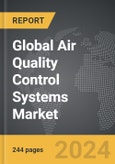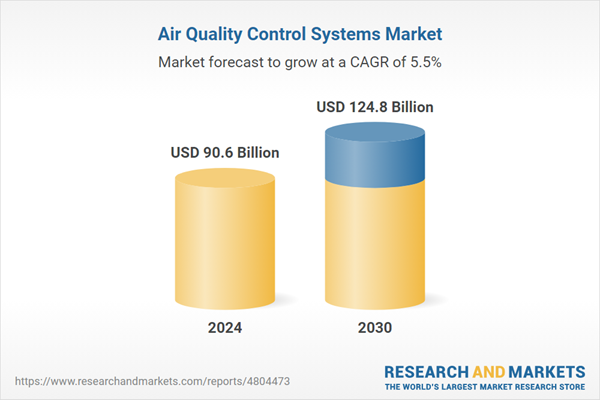The global market for Air Quality Control Systems was valued at US$90.6 Billion in 2024 and is projected to reach US$124.8 Billion by 2030, growing at a CAGR of 5.5% from 2024 to 2030. This comprehensive report provides an in-depth analysis of market trends, drivers, and forecasts, helping you make informed business decisions. The report includes the most recent global tariff developments and how they impact the Air Quality Control Systems market.
Segments: Type (Ambient, Indoor); Product Type (Fabric Filters, Mercury Control Systems, Electrostatic Precipitators, Flue Gas Desulphurization (FGD), Nitrogen Oxide (NOx) Control Systems, Other Product Types); Pollutant Type (Gas, VOCs, Dust, Other Pollutant Types).
Geographic Regions/Countries: World; United States; Canada; Japan; China; Europe (France; Germany; Italy; United Kingdom; Spain; Russia; and Rest of Europe); Asia-Pacific (Australia; India; South Korea; and Rest of Asia-Pacific); Latin America (Argentina; Brazil; Mexico; and Rest of Latin America); Middle East (Iran; Israel; Saudi Arabia; United Arab Emirates; and Rest of Middle East); and Africa.
The analysts continuously track trade developments worldwide, drawing insights from leading global economists and over 200 industry and policy institutions, including think tanks, trade organizations, and national economic advisory bodies. This intelligence is integrated into forecasting models to provide timely, data-driven analysis of emerging risks and opportunities.
Global Air Quality Control Systems Market - Key Trends and Drivers Summarized
Why Are Air Quality Control Systems Essential in Modern Society?
Air Quality Control Systems (AQCS) have become an indispensable component of environmental management, essential for ensuring clean air in both industrial and residential settings. These systems are designed to remove or reduce pollutants from the air, thereby protecting human health and the environment. In industrial settings, AQCS are critical for controlling emissions of harmful substances such as sulfur dioxide (SO2), nitrogen oxides (NO?), and particulate matter, which are byproducts of processes in power plants, manufacturing facilities, and other industries. The significance of these systems is underscored by the increasing global concern over air pollution and its impact on public health, including respiratory and cardiovascular diseases. In residential and commercial environments, air quality control systems, including HVAC systems with advanced filtration technologies, help to ensure safe and comfortable indoor air quality. With urban areas expanding and industrial activities increasing, the need for effective AQCS is more pressing than ever, making them a key focus of both regulatory frameworks and technological innovation.How Are Technological Advancements Shaping the Future of Air Quality Control?
The technological landscape of Air Quality Control Systems has seen significant advancements, driven by the need for more efficient and effective pollution control solutions. Innovations in filtration and scrubbing technologies have enabled more precise removal of pollutants, enhancing the performance of both industrial and residential AQCS. For instance, the development of high-efficiency particulate air (HEPA) filters and activated carbon filters has greatly improved the ability to capture fine particulate matter and volatile organic compounds (VOCs), respectively. Additionally, advancements in catalytic converters and electrostatic precipitators have been pivotal in reducing industrial emissions of NO? and other harmful gases. The integration of IoT and AI technologies into AQCS has further revolutionized the field, allowing for real-time monitoring and control of air quality. These systems can now automatically adjust their operations based on the detected levels of pollutants, optimizing efficiency and reducing energy consumption. As technology continues to evolve, the capabilities of AQCS are expected to expand, providing even greater protection against air pollution.What Are the Key Challenges and Opportunities in the Air Quality Control Market?
The market for Air Quality Control Systems faces a complex set of challenges and opportunities, influenced by regulatory, economic, and technological factors. One of the primary challenges is the stringent regulatory landscape, with governments worldwide imposing strict limits on emissions from industrial and vehicular sources. While these regulations drive demand for AQCS, they also require continuous innovation and adaptation from manufacturers to meet evolving standards. Another challenge is the high initial cost and maintenance expenses associated with advanced AQCS, which can be a barrier for widespread adoption, particularly in developing regions. However, this also presents an opportunity for growth in the market for cost-effective and scalable solutions. Furthermore, the rising awareness of indoor air quality issues, exacerbated by recent global health crises, has led to increased demand for residential and commercial air purification systems. This growing consumer awareness, coupled with advancements in technology, presents significant growth opportunities for the AQCS market, particularly in emerging economies where industrialization and urbanization are on the rise.What Drives the Growth in the Air Quality Control Systems Market?
The growth in the Air Quality Control Systems market is driven by several factors, including technological innovations, increasing industrialization, and heightened awareness of environmental and health issues. The rapid advancement in technologies such as IoT, AI, and advanced filtration materials has made AQCS more efficient and user-friendly, encouraging broader adoption. Additionally, the surge in industrial activities, especially in emerging economies, has created a robust demand for industrial air quality control solutions to comply with stringent environmental regulations. Consumer behavior also plays a crucial role, as increasing awareness about the health impacts of air pollution drives demand for indoor air purification systems. This is particularly evident in urban areas where air quality issues are more pronounced. Furthermore, the expansion of smart city initiatives globally is fostering the integration of advanced AQCS into urban infrastructure, enhancing the market's growth prospects. The continuous push towards sustainability and energy efficiency in all sectors also contributes to the demand for more efficient AQCS, as companies seek to reduce their environmental footprint while optimizing operational costs. As these factors converge, the AQCS market is poised for sustained growth and innovation in the coming years.Report Scope
The report analyzes the Air Quality Control Systems market, presented in terms of units. The analysis covers the key segments and geographic regions outlined below.Segments: Type (Ambient, Indoor); Product Type (Fabric Filters, Mercury Control Systems, Electrostatic Precipitators, Flue Gas Desulphurization (FGD), Nitrogen Oxide (NOx) Control Systems, Other Product Types); Pollutant Type (Gas, VOCs, Dust, Other Pollutant Types).
Geographic Regions/Countries: World; United States; Canada; Japan; China; Europe (France; Germany; Italy; United Kingdom; Spain; Russia; and Rest of Europe); Asia-Pacific (Australia; India; South Korea; and Rest of Asia-Pacific); Latin America (Argentina; Brazil; Mexico; and Rest of Latin America); Middle East (Iran; Israel; Saudi Arabia; United Arab Emirates; and Rest of Middle East); and Africa.
Key Insights:
- Market Growth: Understand the significant growth trajectory of the Ambient Systems segment, which is expected to reach US$86.9 Billion by 2030 with a CAGR of a 5.2%. The Indoor Systems segment is also set to grow at 6.2% CAGR over the analysis period.
- Regional Analysis: Gain insights into the U.S. market, valued at $10.4 Billion in 2024, and China, forecasted to grow at an impressive 6.8% CAGR to reach $31.0 Billion by 2030. Discover growth trends in other key regions, including Japan, Canada, Germany, and the Asia-Pacific.
Why You Should Buy This Report:
- Detailed Market Analysis: Access a thorough analysis of the Global Air Quality Control Systems Market, covering all major geographic regions and market segments.
- Competitive Insights: Get an overview of the competitive landscape, including the market presence of major players across different geographies.
- Future Trends and Drivers: Understand the key trends and drivers shaping the future of the Global Air Quality Control Systems Market.
- Actionable Insights: Benefit from actionable insights that can help you identify new revenue opportunities and make strategic business decisions.
Key Questions Answered:
- How is the Global Air Quality Control Systems Market expected to evolve by 2030?
- What are the main drivers and restraints affecting the market?
- Which market segments will grow the most over the forecast period?
- How will market shares for different regions and segments change by 2030?
- Who are the leading players in the market, and what are their prospects?
Report Features:
- Comprehensive Market Data: Independent analysis of annual sales and market forecasts in US$ Million from 2024 to 2030.
- In-Depth Regional Analysis: Detailed insights into key markets, including the U.S., China, Japan, Canada, Europe, Asia-Pacific, Latin America, Middle East, and Africa.
- Company Profiles: Coverage of players such as ALS Ltd., Babcock & Wilcox Enterprises, Inc., Ducon Technologies, Inc., Foster Wheeler AG, Fujian Longking Co., Ltd. and more.
- Complimentary Updates: Receive free report updates for one year to keep you informed of the latest market developments.
Some of the 41 companies featured in this Air Quality Control Systems market report include:
- ALS Ltd.
- Babcock & Wilcox Enterprises, Inc.
- Ducon Technologies, Inc.
- Foster Wheeler AG
- Fujian Longking Co., Ltd.
- Hamon Corporation
- KC Cottrell Co., Ltd.
- Mitsubishi Hitachi Power Systems Ltd.
- Siemens AG
Tariff Impact Analysis: Key Insights for 2025
Global tariff negotiations across 180+ countries are reshaping supply chains, costs, and competitiveness. This report reflects the latest developments as of April 2025 and incorporates forward-looking insights into the market outlook.The analysts continuously track trade developments worldwide, drawing insights from leading global economists and over 200 industry and policy institutions, including think tanks, trade organizations, and national economic advisory bodies. This intelligence is integrated into forecasting models to provide timely, data-driven analysis of emerging risks and opportunities.
What’s Included in This Edition:
- Tariff-adjusted market forecasts by region and segment
- Analysis of cost and supply chain implications by sourcing and trade exposure
- Strategic insights into geographic shifts
Buyers receive a free July 2025 update with:
- Finalized tariff impacts and new trade agreement effects
- Updated projections reflecting global sourcing and cost shifts
- Expanded country-specific coverage across the industry
Table of Contents
I. METHODOLOGYII. EXECUTIVE SUMMARY2. FOCUS ON SELECT PLAYERSIII. MARKET ANALYSISCANADAITALYSPAINRUSSIAREST OF EUROPESOUTH KOREAREST OF ASIA-PACIFICARGENTINABRAZILMEXICOREST OF LATIN AMERICAIRANISRAELSAUDI ARABIAUNITED ARAB EMIRATESREST OF MIDDLE EASTIV. COMPETITION
1. MARKET OVERVIEW
3. MARKET TRENDS & DRIVERS
4. GLOBAL MARKET PERSPECTIVE
UNITED STATES
JAPAN
CHINA
EUROPE
FRANCE
GERMANY
UNITED KINGDOM
ASIA-PACIFIC
AUSTRALIA
INDIA
LATIN AMERICA
MIDDLE EAST
AFRICA
Companies Mentioned (Partial List)
A selection of companies mentioned in this report includes, but is not limited to:
- ALS Ltd.
- Babcock & Wilcox Enterprises, Inc.
- Ducon Technologies, Inc.
- Foster Wheeler AG
- Fujian Longking Co., Ltd.
- Hamon Corporation
- KC Cottrell Co., Ltd.
- Mitsubishi Hitachi Power Systems Ltd.
- Siemens AG
Table Information
| Report Attribute | Details |
|---|---|
| No. of Pages | 383 |
| Published | April 2025 |
| Forecast Period | 2024 - 2030 |
| Estimated Market Value ( USD | $ 90.6 Billion |
| Forecasted Market Value ( USD | $ 124.8 Billion |
| Compound Annual Growth Rate | 5.5% |
| Regions Covered | Global |









